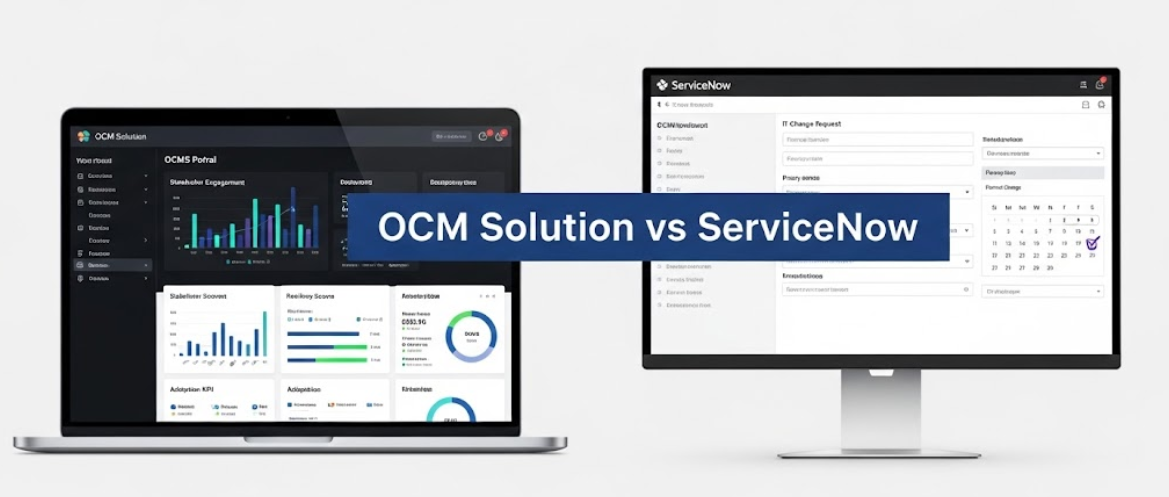OCM Solution vs ServiceNow Change Management – Which Is Best for Your Organization?
Introduction – ServiceNow Change Management vs OCM Solution
When it comes to managing change, ServiceNow Change Management and OCM Solution’s OCMS Portal serve very different purposes, yet both are often compared by organizations exploring change management solutions.
ServiceNow is primarily an IT Service Management (ITSM) platform with change management capabilities designed to control IT changes, reduce risk, and ensure governance. OCM Solution, on the other hand, is a dedicated organizational change management (OCM) software platform built to manage the people side of change across any initiative, not just IT.
If you’ve been searching for “OCM Solution vs ServiceNow”, “ServiceNow change management software comparison”, or “best change management software for enterprises”, this detailed breakdown will help you decide which tool aligns with your goals.

Feature Comparison Table – ServiceNow Change Management vs OCM Solution
| Feature | OCM Solution (OCMS Portal) | ServiceNow Change Management |
|---|---|---|
| Primary Purpose | Full-spectrum organizational change management | IT change management as part of ITSM |
| Scope | Any type of change: technology, process, culture, mergers | Primarily IT infrastructure, applications, and system changes |
| Methodology Support | Supports ADKAR, Kotter, Lewin, and custom OCM frameworks | None; focuses on ITIL change management process |
| Stakeholder Management | Built-in stakeholder mapping, engagement scoring | No stakeholder engagement features |
| Readiness & Impact Assessments | Integrated and reportable | Not applicable; focuses on technical change risk |
| Adoption Tracking | Real-time adoption KPIs | Not designed for people-side adoption metrics |
| Portfolio Management | Change portfolio dashboards & heatmaps | IT change calendar & scheduling |
| Automation & AI | AI-assisted communications, sentiment analysis, adoption risk flagging | Automation for IT workflows and approvals |
| Best For | Organizations needing end-to-end OCM | IT departments managing technical changes |
ServiceNow Change Management: Pros and Cons
Pros:
Deeply integrated with ITSM processes (incident, problem, asset management)
Robust governance and approval workflows for IT changes
Strong automation for IT change scheduling and risk control
Widely adopted in enterprise IT environments
Cons:
Focused on IT changes, not organization-wide transformation
No OCM methodology support or people-side change tools
No stakeholder or adoption tracking features
Can be complex and costly to implement for non-IT purposes
OCM Solution for Change Management: Pros and Cons
Pros:
Purpose-built for organizational change across all industries
Full methodology flexibility (ADKAR, Kotter, Lewin, custom)
Built-in stakeholder, readiness, and impact assessment tools
Real-time adoption analytics and change portfolio governance
AI-assisted communication and sentiment monitoring
Scales from small teams to global enterprises
Cons:
Not an ITSM platform; would require integration for IT change governance
Best suited for organizations committed to structured OCM processes
When to Choose Each Platform – ServiceNow Change Management or OCM Solution?
Choose OCM Solution’s OCMS Portal if:
You want a software platform dedicated to managing the people side of change
You need stakeholder engagement, readiness scoring, and adoption tracking
You manage change initiatives beyond IT, such as process, cultural, or strategic transformations
You want a methodology-flexible system with real-time analytics
Choose ServiceNow Change Management if:
You manage large volumes of IT changes and need strict governance
You are already using ServiceNow ITSM and want an integrated IT change process
Your primary concern is technical risk reduction and approval workflows
Conclusion – ServiceNow Change Management vs OCM Solution
While ServiceNow Change Management is a recognized leader in IT change governance, its strengths lie primarily in managing technical changes, system updates, and infrastructure risk. What it does not address are the broader people-focused needs of organizational change, such as stakeholder engagement, change readiness, communication strategies, and cultural alignment. These elements are critical for ensuring that new processes, technologies, and initiatives are embraced across all levels of the organization.
For enterprise transformations that involve shifts in culture, behaviors, and cross-functional ways of working, OCM Solution’s OCMS Portal delivers a purpose-built platform with specialized tools, proven methodologies, and real-time reporting to drive adoption, reduce resistance, and sustain results long after go-live. The platform’s focus on the people side of change ensures that initiatives don’t just launch, they succeed.
Many organizations find that the most effective approach is using both: ServiceNow to manage IT changes with precision, and OCM Solution to manage organization-wide change with impact. Together, they provide a complete, integrated change management ecosystem that aligns technical execution with human adoption, ensuring transformations deliver measurable business outcomes.
FAQs
Not directly. ServiceNow is designed for IT change governance, not people-side OCM.
Yes, OCM Solution can be integrated for unified reporting between IT changes and organizational change initiatives.
OCM Solution is better for non-IT organizational change; ServiceNow is better for IT change governance.
No. Its change management focuses on ITIL processes.
Yes. Many enterprises run both, using ServiceNow for IT changes and OCM Solution for people-focused change management.Is ServiceNow good for organizational change management?
Can OCM Solution integrate with ServiceNow?
Which is better for enterprise change?
Does ServiceNow have OCM features?
Can these platforms be used together?
